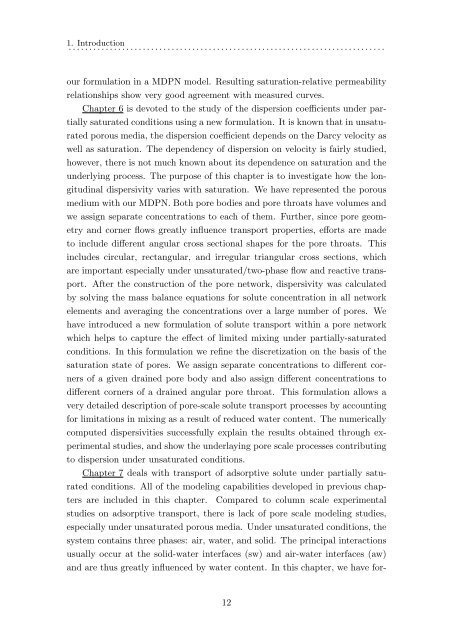download pdf version of PhD book - Universiteit Utrecht
download pdf version of PhD book - Universiteit Utrecht
download pdf version of PhD book - Universiteit Utrecht
Create successful ePaper yourself
Turn your PDF publications into a flip-book with our unique Google optimized e-Paper software.
1. Introduction<br />
. . . . . . . . . . . . . . . . . . . . . . . . . . . . . . . . . . . . . . . . . . . . . . . . . . . . . . . . . . . . . . . . . . . . . . . . . . . . .<br />
our formulation in a MDPN model. Resulting saturation-relative permeability<br />
relationships show very good agreement with measured curves.<br />
Chapter 6 is devoted to the study <strong>of</strong> the dispersion coefficients under partially<br />
saturated conditions using a new formulation. It is known that in unsaturated<br />
porous media, the dispersion coefficient depends on the Darcy velocity as<br />
well as saturation. The dependency <strong>of</strong> dispersion on velocity is fairly studied,<br />
however, there is not much known about its dependence on saturation and the<br />
underlying process. The purpose <strong>of</strong> this chapter is to investigate how the longitudinal<br />
dispersivity varies with saturation. We have represented the porous<br />
medium with our MDPN. Both pore bodies and pore throats have volumes and<br />
we assign separate concentrations to each <strong>of</strong> them. Further, since pore geometry<br />
and corner flows greatly influence transport properties, efforts are made<br />
to include different angular cross sectional shapes for the pore throats. This<br />
includes circular, rectangular, and irregular triangular cross sections, which<br />
are important especially under unsaturated/two-phase flow and reactive transport.<br />
After the construction <strong>of</strong> the pore network, dispersivity was calculated<br />
by solving the mass balance equations for solute concentration in all network<br />
elements and averaging the concentrations over a large number <strong>of</strong> pores. We<br />
have introduced a new formulation <strong>of</strong> solute transport within a pore network<br />
which helps to capture the effect <strong>of</strong> limited mixing under partially-saturated<br />
conditions. In this formulation we refine the discretization on the basis <strong>of</strong> the<br />
saturation state <strong>of</strong> pores. We assign separate concentrations to different corners<br />
<strong>of</strong> a given drained pore body and also assign different concentrations to<br />
different corners <strong>of</strong> a drained angular pore throat. This formulation allows a<br />
very detailed description <strong>of</strong> pore-scale solute transport processes by accounting<br />
for limitations in mixing as a result <strong>of</strong> reduced water content. The numerically<br />
computed dispersivities successfully explain the results obtained through experimental<br />
studies, and show the underlaying pore scale processes contributing<br />
to dispersion under unsaturated conditions.<br />
Chapter 7 deals with transport <strong>of</strong> adsorptive solute under partially saturated<br />
conditions. All <strong>of</strong> the modeling capabilities developed in previous chapters<br />
are included in this chapter. Compared to column scale experimental<br />
studies on adsorptive transport, there is lack <strong>of</strong> pore scale modeling studies,<br />
especially under unsaturated porous media. Under unsaturated conditions, the<br />
system contains three phases: air, water, and solid. The principal interactions<br />
usually occur at the solid-water interfaces (sw) and air-water interfaces (aw)<br />
and are thus greatly influenced by water content. In this chapter, we have for-<br />
12

















